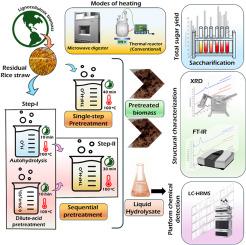连续微波和常规等温稀酸-有机溶剂预处理水稻秸秆分馏高糖和平台化学品:可持续发展的概念
IF 5.8
2区 生物学
Q1 AGRICULTURAL ENGINEERING
引用次数: 0
摘要
研究了稀酸和四氢呋喃预处理(DASQ)在较低温度和较低时间下对水稻秸秆的顺序预处理效果。在本研究中,采用常规和微波(MW)加热方法进行预处理,分析两种预处理方法的效率。结果表明,采用稀酸预处理+四氢呋喃-水(THF-H2O)预处理的DASQ法可获得较高的总还原糖含量(96.8% /纸浆,80.9% /生物质),高于单步法和自水解有机溶剂顺序法(AHSQ)预处理。此外,使用基于电加热的热反应器(TR)作为传统热源进行预处理系统的糖收率相对较低。MW-DASQ体系的单糖得率为67.5%。FTIR分析显示,经过MW-DASQ预处理的RS相对波段强度发生了变化,其横向有序指数(0.75)和总结晶度指数(0.68)分别低于未经处理的RS(0.77)和1.15。用XRD计算的CrI也从未处理RS的52.1%下降到MW-DASQ预处理后的41.3%。此外,LC-HRMS对预处理的水解产物也检测到11种有用的平台化学物质。总的来说,目前的研究结果表明,MW-DASQ系统可以高效地生产出高糖收率和富含平台的水解产物,这对于实现可持续发展的绿色生物炼制概念是有用的。本文章由计算机程序翻译,如有差异,请以英文原文为准。

Sequential microwave and conventional isothermal dilute acid-organosolv pretreatment of rice straw fractionation for high sugar yield and platform chemicals: A concept for sustainable development
The efficiency of a sequential pretreatment approach on rice straw (RS) involving dilute acid and tetrahydrofuran-based pretreatment (DASQ) using lower temperatures and time regimens was investigated. In the present study, conventional and microwave (MW) heating approaches were used for pretreatment to analyze the efficiency of both pretreatments. It was observed that the DASQ method using dilute acid pretreatment followed by tetrahydrofuran-water (THF-H2O) pretreatments was found to be more effective in yielding high total reducing sugar contents of 96.8 % per pulp and 80.9 % per biomass, which was higher than that of the single step process and autohydrolysis organosolv sequential (AHSQ) pretreatments. Also, the sugar yields were comparatively low for the pretreatment systems performed using an electric-heating-based thermal reactor (TR) as a conventional heating source. The monomeric sugar yields of the MW-DASQ system were observed to be 67.5 %. FTIR analysis showed variations in relative band intensities of the MW-DASQ pretreated RS. They observed a lowered lateral order index (0.75) and total crystallinity index (0.68) of the MW-DASQ pretreated RS, compared to the untreated RS, which was 0.77 and 1.15, respectively. CrI calculated using XRD was also found to drop from 52.1 % of the untreated RS to 41.3 % after MW-DASQ pretreatment. Further, LC-HRMS performed on the pretreatment hydrolysates also detected eleven (11) useful platform chemicals. Overall, the present results reveal that the MW-DASQ system can efficiently produce a highly hydrolyzable solid fraction with a high sugar yield and platform-rich hydrolysates, which can be useful for achieving green biorefinery concepts for sustainable development.
求助全文
通过发布文献求助,成功后即可免费获取论文全文。
去求助
来源期刊

Biomass & Bioenergy
工程技术-能源与燃料
CiteScore
11.50
自引率
3.30%
发文量
258
审稿时长
60 days
期刊介绍:
Biomass & Bioenergy is an international journal publishing original research papers and short communications, review articles and case studies on biological resources, chemical and biological processes, and biomass products for new renewable sources of energy and materials.
The scope of the journal extends to the environmental, management and economic aspects of biomass and bioenergy.
Key areas covered by the journal:
• Biomass: sources, energy crop production processes, genetic improvements, composition. Please note that research on these biomass subjects must be linked directly to bioenergy generation.
• Biological Residues: residues/rests from agricultural production, forestry and plantations (palm, sugar etc), processing industries, and municipal sources (MSW). Papers on the use of biomass residues through innovative processes/technological novelty and/or consideration of feedstock/system sustainability (or unsustainability) are welcomed. However waste treatment processes and pollution control or mitigation which are only tangentially related to bioenergy are not in the scope of the journal, as they are more suited to publications in the environmental arena. Papers that describe conventional waste streams (ie well described in existing literature) that do not empirically address ''new'' added value from the process are not suitable for submission to the journal.
• Bioenergy Processes: fermentations, thermochemical conversions, liquid and gaseous fuels, and petrochemical substitutes
• Bioenergy Utilization: direct combustion, gasification, electricity production, chemical processes, and by-product remediation
• Biomass and the Environment: carbon cycle, the net energy efficiency of bioenergy systems, assessment of sustainability, and biodiversity issues.
 求助内容:
求助内容: 应助结果提醒方式:
应助结果提醒方式:


